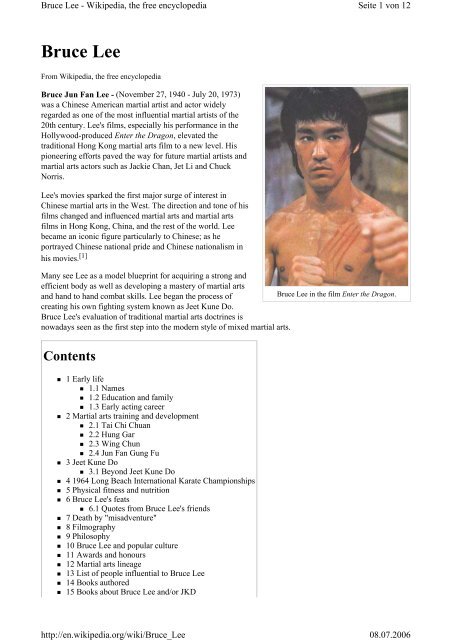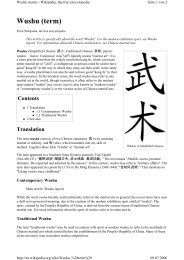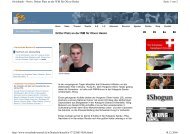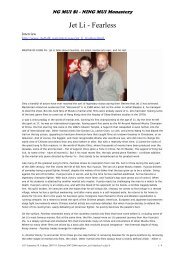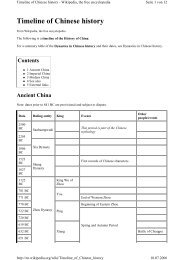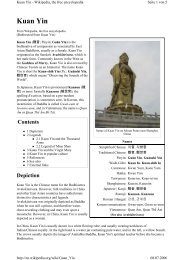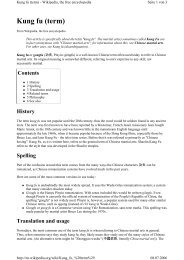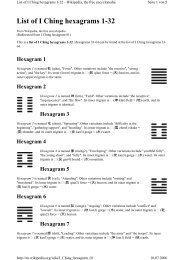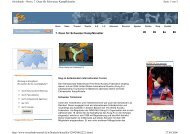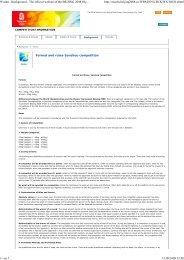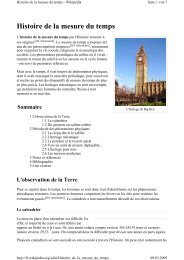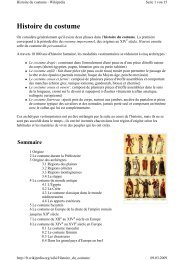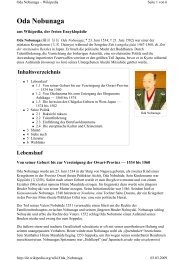Bruce Lee - Ning Mui Kung Fu Organisation
Bruce Lee - Ning Mui Kung Fu Organisation
Bruce Lee - Ning Mui Kung Fu Organisation
Create successful ePaper yourself
Turn your PDF publications into a flip-book with our unique Google optimized e-Paper software.
<strong>Bruce</strong> <strong>Lee</strong> - Wikipedia, the free encyclopedia<br />
<strong>Bruce</strong> <strong>Lee</strong><br />
From Wikipedia, the free encyclopedia<br />
<strong>Bruce</strong> Jun Fan <strong>Lee</strong> - (November 27, 1940 - July 20, 1973)<br />
was a Chinese American martial artist and actor widely<br />
regarded as one of the most influential martial artists of the<br />
20th century. <strong>Lee</strong>'s films, especially his performance in the<br />
Hollywood-produced Enter the Dragon, elevated the<br />
traditional Hong Kong martial arts film to a new level. His<br />
pioneering efforts paved the way for future martial artists and<br />
martial arts actors such as Jackie Chan, Jet Li and Chuck<br />
Norris.<br />
<strong>Lee</strong>'s movies sparked the first major surge of interest in<br />
Chinese martial arts in the West. The direction and tone of his<br />
films changed and influenced martial arts and martial arts<br />
films in Hong Kong, China, and the rest of the world. <strong>Lee</strong><br />
became an iconic figure particularly to Chinese; as he<br />
portrayed Chinese national pride and Chinese nationalism in<br />
his movies. [1]<br />
Many see <strong>Lee</strong> as a model blueprint for acquiring a strong and<br />
efficient body as well as developing a mastery of martial arts<br />
and hand to hand combat skills. <strong>Lee</strong> began the process of<br />
<strong>Bruce</strong> <strong>Lee</strong> in the film Enter the Dragon.<br />
creating his own fighting system known as Jeet Kune Do.<br />
<strong>Bruce</strong> <strong>Lee</strong>'s evaluation of traditional martial arts doctrines is<br />
nowadays seen as the first step into the modern style of mixed martial arts.<br />
Contents<br />
� 1 Early life<br />
� 1.1 Names<br />
� 1.2 Education and family<br />
� 1.3 Early acting career<br />
� 2 Martial arts training and development<br />
� 2.1 Tai Chi Chuan<br />
� 2.2 Hung Gar<br />
� 2.3 Wing Chun<br />
� 2.4 Jun Fan Gung <strong>Fu</strong><br />
� 3 Jeet Kune Do<br />
� 3.1 Beyond Jeet Kune Do<br />
� 4 1964 Long Beach International Karate Championships<br />
� 5 Physical fitness and nutrition<br />
� 6 <strong>Bruce</strong> <strong>Lee</strong>'s feats<br />
� 6.1 Quotes from <strong>Bruce</strong> <strong>Lee</strong>'s friends<br />
� 7 Death by "misadventure"<br />
� 8 Filmography<br />
� 9 Philosophy<br />
� 10 <strong>Bruce</strong> <strong>Lee</strong> and popular culture<br />
� 11 Awards and honours<br />
� 12 Martial arts lineage<br />
� 13 List of people influential to <strong>Bruce</strong> <strong>Lee</strong><br />
� 14 Books authored<br />
� 15 Books about <strong>Bruce</strong> <strong>Lee</strong> and/or JKD<br />
http://en.wikipedia.org/wiki/<strong>Bruce</strong>_<strong>Lee</strong><br />
Seite 1 von 12<br />
08.07.2006
<strong>Bruce</strong> <strong>Lee</strong> - Wikipedia, the free encyclopedia<br />
� 16 <strong>Bruce</strong> <strong>Lee</strong> documentaries<br />
� 17 References<br />
� 18 See also<br />
� 19 External links<br />
Early life<br />
<strong>Bruce</strong> <strong>Lee</strong> was an American Born Chinese (ABC) born at the Chinese Hospital [2] in San Francisco in 1940 to<br />
his Chinese father <strong>Lee</strong> Hoi-Chuen (李海泉) and Chinese-German [3] mother Grace <strong>Lee</strong> (何金棠). <strong>Bruce</strong>'s<br />
maternal grandmother was Chinese and his maternal grandfather was German.<br />
Names<br />
<strong>Bruce</strong>'s Cantonese given name, Jun Fan (振藩; Mandarin Pinyin:<br />
Zhènfán), literally means "invigorate San Francisco" (三藩市). [4] At<br />
birth, he was given the English name "<strong>Bruce</strong>" by Dr. Mary Glover. Mrs.<br />
<strong>Lee</strong> had not initially planned on an American name but deemed it<br />
appropriate and concurred with Dr. Glover. [5] Interestingly the name<br />
"<strong>Bruce</strong>" was never used within his family until he enrolled in La Salle<br />
College, a Hong Kong high school, at 12 years of age, [4] and then again<br />
at another Catholic boys' school, St Francis Xavier's College, Kowloon,<br />
where he represented their boxing team in inter-school events.<br />
In addition, <strong>Lee</strong> initially had a birth name Li Yuen Kam [1] (李炫金);<br />
Mandarin Pinyin: Lǐ Xuànjīn) given by his mother, as at the time <strong>Lee</strong>'s<br />
father was away on a Chinese opera tour. After several months, when<br />
<strong>Lee</strong>'s father returned, the name was abandoned because of a conflict with the name of <strong>Lee</strong>'s grandfather. <strong>Lee</strong><br />
was then renamed Jun Fan. Finally, <strong>Lee</strong> was also given a feminine name, Sai <strong>Fu</strong>ng (細鳳, literally "small<br />
phoenix"), used throughout his early childhood in keeping with a Chinese custom traditionally thought to hide<br />
the child from evil spirits.<br />
<strong>Bruce</strong> <strong>Lee</strong>'s screen name was <strong>Lee</strong> Siu Lung in Cantonese and Li Xiao Long in Mandarin (李小龍; Cantonese<br />
pengyam: Ley 5 Siw 2 Long 4 ; Mandarin Pinyin: Lǐ Xiǎolóng) which literally means "<strong>Lee</strong> Little Dragon." These<br />
were first used by director 袁步雲 of the 1950 Cantonese movie 細路祥 in which <strong>Lee</strong> performed. It is<br />
possible that that the name "little dragon" was chosen based on his childhood name "small phoenix". In<br />
Chinese tradition, the Chinese dragon and phoenix come in pairs to represent the male and female genders,<br />
respectively. However, it is more likely that he was called Little Dragon because he was born in the Year of<br />
the Dragon in the Hour of the Dragon, according to the Chinese zodiac.<br />
Education and family<br />
Seite 2 von 12<br />
Screenshot from Thunderstorm,<br />
one of a few movies <strong>Lee</strong> Siu<br />
Lung starred in as a teenager.<br />
At age 14, <strong>Bruce</strong> <strong>Lee</strong> entered La Salle College, a high school, under the wing of Brother Henry. Then, he<br />
attended St Francis Xavier's College from 1957-1959.<br />
In 1959, <strong>Bruce</strong> got into a fight with a feared Triad gang member's son, his father became concerned about<br />
young <strong>Bruce</strong>'s safety and as a result, he and his wife decided to send <strong>Bruce</strong> to the United States to live with an<br />
old friend of his father's. All he had was $100 in his pocket and the title of 1958 Crown Colony Cha Cha<br />
Champion of Hong Kong. After living in San Francisco, he moved to Seattle to work for Ruby Chow, another<br />
friend of his father's. In 1959, <strong>Lee</strong> completed his high school education in Seattle and received his diploma<br />
from Edison Technical School. He enrolled at the University of Washington as a philosophy major. It was at<br />
the University of Washington that he met his future wife Linda Emery, whom he would marry in 1964.<br />
<strong>Bruce</strong> and Linda had two children together, Brandon <strong>Lee</strong> (born 1965) and Shannon <strong>Lee</strong> (born 1969). Brandon,<br />
http://en.wikipedia.org/wiki/<strong>Bruce</strong>_<strong>Lee</strong><br />
08.07.2006
<strong>Bruce</strong> <strong>Lee</strong> - Wikipedia, the free encyclopedia<br />
an actor like his father, died on a movie set while filming The Crow on March 31, 1993.<br />
Early acting career<br />
A few credits short of graduation from the University of Washington as a philosophy major, <strong>Lee</strong> headed to<br />
San Francisco and then Hollywood.<br />
In 1964 at a demonstration in Long Beach, California, the soon-to-be-famous <strong>Bruce</strong> <strong>Lee</strong> met karate black belt<br />
champion Chuck Norris. <strong>Lee</strong> would later introduce Norris to portray one of <strong>Lee</strong>'s opponents in Return of the<br />
Dragon, also known as Way of the Dragon, in a famous Colosseum fight scene regarded by many as one of<br />
the best martial arts fights ever filmed.<br />
<strong>Lee</strong> went on to star as Kato in the TV series The Green Hornet, which ran from 1966 to 1967 and afterward<br />
opened up his own Jeet Kune Do school. Later <strong>Lee</strong> would use filmmaking to demonstrate his martial arts<br />
fighting techniques and theories.<br />
He had created the character idea for the role of Kwai-Chang-Caine for the TV Series <strong>Kung</strong> <strong>Fu</strong>, but the role<br />
eventually went to David Carradine instead.<br />
Martial arts training and development<br />
Tai Chi Chuan<br />
Young <strong>Bruce</strong> learned the fundamentals of Wu style Tai Chi Chuan from his father, <strong>Lee</strong> Hoi Cheun. <strong>Lee</strong>'s<br />
Wing Chun Sifu, Yip Man, was also a colleague and friend of Hong Kong Wu family teacher Wu Ta-chi. He<br />
always held that the principles of Tai Chi Chuan influenced his view of martial arts all through his life as an<br />
actor and a martial artist. While it is obvious that the style studied by his father was the Wu style, <strong>Lee</strong> was<br />
seen on at least one occasion demonstrating the 108 Basic Movements of the Yang form.<br />
Hung Gar<br />
In between the learning of Tai Chi and Wing Chun, <strong>Lee</strong> also learned bits and pieces of the <strong>Kung</strong> fu style<br />
Hung Gar from a friend of his father. While we do not know how much he learned of this particular martial<br />
art, there are photographs of <strong>Bruce</strong> demonstrating animal stances and forms found within its teachings.<br />
Wing Chun<br />
<strong>Bruce</strong> <strong>Lee</strong> began his formal martial arts training at the age of 14 in Wing Chun under Hong Kong Wing Chun<br />
master Yip Man. <strong>Bruce</strong> was introduced to Sifu Yip Man by William Cheung, who was then a live-in student<br />
of Yip Man, in early 1954. Like most martial arts schools at that time, Sifu Yip Man's classes were often<br />
taught by the highest ranking students. One of the highest ranking students under Yip Man at the time of <strong>Lee</strong>'s<br />
training was Wong Shun-leung, who is understood to have had the largest influence. <strong>Lee</strong> would leave before<br />
learning the entire Wing Chun curriculum, but Wing Chun formed a base for his later explorations of martial<br />
arts and development of Jeet Kune Do.<br />
<strong>Bruce</strong> <strong>Lee</strong>'s first formal, organized bout came as a teenager at his high school in Hong Kong. He was to fight<br />
a young British boxer, a reigning two-time boxing champion. <strong>Bruce</strong> knocked his opponent out with repeated<br />
strikes, using the Wing Chun technique jik chung chuy.<br />
Jun Fan Gung <strong>Fu</strong><br />
Main article: Jun Fan Gung <strong>Fu</strong><br />
http://en.wikipedia.org/wiki/<strong>Bruce</strong>_<strong>Lee</strong><br />
Seite 3 von 12<br />
08.07.2006
<strong>Bruce</strong> <strong>Lee</strong> - Wikipedia, the free encyclopedia<br />
It would not be until his arrival in the United States, however, that <strong>Lee</strong> began the process of creating his own<br />
system, which he would later teach at the martial arts schools he opened first in Seattle starting with judo<br />
practitioner Jesse Glover as his first student who later became his first assistant instructor, and the first person<br />
authorized by <strong>Lee</strong> to teach aspects of <strong>Bruce</strong> <strong>Lee</strong>'s Gung <strong>Fu</strong>. After moving to Oakland and Los Angeles,<br />
California <strong>Lee</strong> opened his martial arts school named the <strong>Lee</strong> Jun Fan Gung <strong>Fu</strong> Institute.<br />
Jeet Kune Do<br />
Main article: Jeet Kune Do<br />
<strong>Bruce</strong> <strong>Lee</strong> believed that martial arts styles were limited by their very<br />
nature. Instead, he emphasized what he called "the style of no style". This<br />
consisted of utilizing a non-formalized approach which <strong>Lee</strong> claimed was<br />
not indicative of traditional styles. <strong>Lee</strong> named his martial arts system Jun<br />
Fan Gung <strong>Fu</strong>, which consisted mostly of elements of Wing Chun, with<br />
elements of Western Boxing, Fencing, and other martial arts. <strong>Lee</strong> later<br />
expanded his personal system over time, to include elements from Indo-<br />
Malay Silat, Panantukan, Sikaran, Catch Wrestling, Karate, Judo, Jujitsu,<br />
Taekwondo, and other martial arts. Eventually Jun Fan Gung <strong>Fu</strong><br />
transformed itself to what he would come to describe as Jeet Kune Do or<br />
the Way of the Intercepting Fist, a term he would later regret because Jeet<br />
Kune Do implied specific parameters that styles connotate whereas the<br />
whole point of the system was to exist outside of parameters and<br />
limitations. Some confuse the Jeet Kune Do system with the personal<br />
version that <strong>Bruce</strong> <strong>Lee</strong> practised. Jeet Kune Do can be seen as both a<br />
process and a product, the latter deriving from the former.<br />
<strong>Lee</strong> claimed that, after arriving in San Francisco, his theories about<br />
martial arts and his teaching of "secret" Chinese martial arts to non-Asian<br />
students gave him enemies in the martial arts community. A contest was scheduled between him and Wong<br />
Jack Man, a practitioner of Northern Shaolin <strong>Kung</strong> fu.<br />
<strong>Bruce</strong> <strong>Lee</strong>'s description of the fight was that Wong Jack Man challenged him to a duel over his decision to<br />
teach non-Chinese students. <strong>Bruce</strong> <strong>Lee</strong> accepted the challenge. Many who witnessed the fight believed <strong>Lee</strong><br />
had won the duel, however Wong disputes this. <strong>Lee</strong> later took the view that the fight took "too long" because<br />
traditional martial arts techniques were too rigid and formalistic to be practical in scenarios of chaotic street<br />
fighting. Perhaps as a result of this fight, he decided to develop a system with an emphasis on "practicality,<br />
flexibilty, speed, and efficiency".<br />
Beyond Jeet Kune Do<br />
Seite 4 von 12<br />
The Jeet Kune Do Emblem. The<br />
Chinese characters around the<br />
Taijitu symbol indicate: "Using<br />
no way as way" & "Having no<br />
limitation as limitation" The<br />
arrows represent the endless<br />
movement and change of the<br />
universe.<br />
The match with Wong influenced <strong>Lee</strong>'s philosophy on fighting. <strong>Lee</strong> believed that the fight had lasted too long<br />
and that he had failed to live up to his potential. At this point he decided to start different methods of training<br />
such as weight training for strength, running for endurance, stretching for flexibility, and many others which<br />
he constantly adapted.<br />
<strong>Bruce</strong> <strong>Lee</strong> certified three instructors: Dan Inosanto, Taky Kimura, and James Yimm <strong>Lee</strong> (no relation to <strong>Bruce</strong><br />
<strong>Lee</strong>). James Yimm <strong>Lee</strong>, a close friend of <strong>Bruce</strong> <strong>Lee</strong>, died without certifying additional students. Taky Kimura,<br />
to date, has certified one person in Jun Fan Gung <strong>Fu</strong>: his son and heir Andy Kimura. All other instructors are<br />
certified under Dan Inosanto. Prior to his death, <strong>Lee</strong> told his then only two living instructors Inosanto and<br />
Kimura (James Yimm <strong>Lee</strong> had died in 1972.) to dismantle his schools. Both Taky Kimura and Dan Inosanto<br />
were allowed to teach small classes thereafter without using the name Jeet Kune Do. <strong>Lee</strong> specifically said to<br />
Inosanto "Keep the numbers small and the quality high".<br />
http://en.wikipedia.org/wiki/<strong>Bruce</strong>_<strong>Lee</strong><br />
08.07.2006
<strong>Bruce</strong> <strong>Lee</strong> - Wikipedia, the free encyclopedia<br />
As a result of a lawsuit between the estate of <strong>Bruce</strong> <strong>Lee</strong> (also known as Concord Moon) and the Inosanto<br />
Academy, the name "Jun Fan Jeet Kune Do" was legally trademarked, and the rights were given solely to the<br />
<strong>Lee</strong> estate. "The name is made up of two parts: 'Jun Fan' (<strong>Bruce</strong>’s given Chinese name) and 'Jeet Kune<br />
Do' (the Way of the Intercepting Fist). The development of <strong>Bruce</strong> <strong>Lee</strong>’s art from 1961 until the end of his life<br />
was one smooth and indivisible path. In the beginning, he referred to his teachings simply as Jun Fan Gung<br />
<strong>Fu</strong>. Later he further refined his art as a unique Gung fu all its own – Jeet Kune Do" (from the <strong>Bruce</strong> <strong>Lee</strong><br />
Foundation Web site).<br />
Some martial arts instructors, in an effort to promote themselves or their martial arts schools, make dubious<br />
claims about learning from or teaching <strong>Bruce</strong> <strong>Lee</strong>. There are only a few living people who can trace their<br />
lineage directly to <strong>Bruce</strong> <strong>Lee</strong>.<br />
1964 Long Beach International Karate Championships<br />
At the invitation of Ed Parker, <strong>Lee</strong> appeared in the 1964 Long Beach<br />
International Karate Championship (http://www.longbeachikc.com/)<br />
and performed repetitions of two-finger pushups (using the thumb and<br />
the index finger) with feet at approximately a shoulder-width apart. In<br />
the same Long Beach event he also performed the "One inch punch".<br />
The description of which is as follows: <strong>Lee</strong> stood upright, his right<br />
foot forward with knees bent slightly, in front of a standing, stationary<br />
partner. <strong>Lee</strong>'s right arm was partly extended and his right fist<br />
<strong>Bruce</strong> <strong>Lee</strong>'s "One inch punch"<br />
approximately an inch away from the partner's chest. Without<br />
retracting his right arm, <strong>Lee</strong> then forcibly delivered the punch to his<br />
partner while largely maintaining his posture, sending the partner backwards and falling into a chair placed<br />
behind the partner to prevent injury, though the force of the impact caused his partner to soon after fall onto<br />
the floor.<br />
Physical fitness and nutrition<br />
Seite 5 von 12<br />
<strong>Bruce</strong> <strong>Lee</strong> felt that many martial artists of his day did not spend<br />
enough time on physical conditioning. <strong>Bruce</strong> did not resort to<br />
traditional bodybuilding techniques to build mass; he was more<br />
interested in speed and power.<br />
The weight training program that <strong>Lee</strong> used during a stay in Hong<br />
Kong in 1965 indicated bicep curls of eighty pounds and eight<br />
repetitions [6] for endurance. This translates to an estimated one<br />
repetition maximum of 110 pounds, [7] placing <strong>Lee</strong> in approximately<br />
the 100th percentile for the 121 to 140 pound weight class. [8]<br />
<strong>Lee</strong> believed that the abdominal muscles were one of the most<br />
important muscle groups for a martial artist, since virtually every<br />
movement requires some degree of abdominal work. Perhaps more<br />
<strong>Lee</strong> flexing (1972), front<br />
importantly, the "abs" are like a shell, protecting the ribs and vital<br />
organs. <strong>Bruce</strong> <strong>Lee</strong>'s washboard abs did not come from mere<br />
abdominal training; he was also a proponent of cardiovascular conditioning and would regularly run, jump<br />
rope, and ride a stationary bicycle. A typical exercise for <strong>Lee</strong> would be to run a distance of two to six miles in<br />
fifteen to forty-five minutes.<br />
Another element in <strong>Bruce</strong> <strong>Lee</strong>'s quest for abdominal definition was nutrition. According to Linda <strong>Lee</strong>, soon<br />
after he moved to the United States, <strong>Bruce</strong> started to take nutrition seriously and developed an interest in<br />
http://en.wikipedia.org/wiki/<strong>Bruce</strong>_<strong>Lee</strong><br />
08.07.2006
<strong>Bruce</strong> <strong>Lee</strong> - Wikipedia, the free encyclopedia<br />
health foods and high-protein drinks. He ate lean meat sparingly and consumed large amounts of fruits and<br />
vegetables.<br />
<strong>Bruce</strong> <strong>Lee</strong>'s feats<br />
� <strong>Bruce</strong> <strong>Lee</strong>'s striking speed from 2 feet away was five hundredths of a<br />
second. (Glover [9] )<br />
� <strong>Bruce</strong> did one-hand push ups using only 2 fingers.<br />
� <strong>Bruce</strong> was able to break a 150lb bag with a sidekick. (Coburn [9] )<br />
� <strong>Bruce</strong> would ride for 45 minutes (10 Miles) on a stationary bike,<br />
sweating profusely afterwards. (Uhera [9] )<br />
� <strong>Bruce</strong>'s last movie Enter the Dragon was made for US$850,000 in 1973<br />
($3.74 million in 2005 currency. BLS [10] ). To date, Enter the Dragon<br />
has grossed over $100,000,000. (IMDB.com [11] )<br />
� <strong>Bruce</strong> was able to hold a 125-pound barbell at arms length in front of<br />
him (with elbows locked) for several seconds. (Little [12] )<br />
Quotes from <strong>Bruce</strong> <strong>Lee</strong>'s friends<br />
Seite 6 von 12<br />
<strong>Bruce</strong> <strong>Lee</strong>'s two finger<br />
push ups<br />
These are some quotes from <strong>Bruce</strong> <strong>Lee</strong>'s students and people who trained with him about his feats of strength:<br />
[9]<br />
� Chuck Norris<br />
� "<strong>Lee</strong>, pound for pound, might well have been one of the strongest men in the world, and<br />
certainly one of the quickest."<br />
� Doug Palmer<br />
� "<strong>Bruce</strong> was like the Michael Jordan or Muhammad Ali in his prime, somebody who stood above<br />
everyone else. It's not that the other martial artists weren't good. It's just that this guy was great."<br />
� Herb Jackson<br />
� "The biggest problem in designing equipment for <strong>Bruce</strong> was that he'd go through it so damn fast.<br />
I had to reinforce his wooden dummy with automobile parts so he could train on it without<br />
breaking it. I had started to build him a mobile dummy that could actually attack and retreat to<br />
better simulate "live" combat, sadly <strong>Bruce</strong> died before the machine was built. It would have<br />
been strung up by big high-tension cables that I was going to connect between two posts, one on<br />
either side of his backyard. The reason for the machine was simply because no one could stand<br />
up to his full force punches and kicks, <strong>Bruce</strong>'s strength and skill had evolved to a point where he<br />
had to fight machines."<br />
� "He never trained in a gym, he thought he could concentrate better at home, so he worked out on<br />
his patio. He had a small weight set, something like a standard 100lb cast-iron set. In addition,<br />
he had a 310lb Olympic barbell set, a bench press and some dumbbells, both solid and<br />
adjustable."<br />
� "<strong>Bruce</strong> used to beat all other comers at this type of wrist wrestling and even joked that he<br />
wanted to be world champion at it."<br />
� James Coburn<br />
� "<strong>Bruce</strong> and I were training out on my patio one day, we were using this giant bag for side kicks,<br />
I guess it weighed about 150lbs. <strong>Bruce</strong> looked at it and just went Bang, it shot up out into the<br />
lawn about 15ft in the air, it then busted in the middle. It was filled with little bits and pieces of<br />
rag, we were picking up bits of rag for months."<br />
� Jesse Glover<br />
� "When he could do push ups on his thumbs and push ups with 250lbs on his back, he moved on<br />
to other exercises."<br />
� "The power that <strong>Lee</strong> was capable of instantly generating was absolutely frightening to his fellow<br />
martial artists, especially his sparring partners, and his speed was equally intimidating. We<br />
timed him with an electric timer once, and <strong>Bruce</strong>'s quickest movements were around five<br />
hundredths of a second, his slowest were around eight hundredths. This was punching from a<br />
relaxed position with his hands down at his sides from a distance between 18-24 inches. Not<br />
http://en.wikipedia.org/wiki/<strong>Bruce</strong>_<strong>Lee</strong><br />
08.07.2006
<strong>Bruce</strong> <strong>Lee</strong> - Wikipedia, the free encyclopedia<br />
only was he amazingly quick, but he could read you too. He could pick up on small subtle things<br />
that you were getting ready to do and then he'd just shut you down."<br />
� "<strong>Bruce</strong> was gravitating more and more toward weight training as he would use the weighted<br />
wall pulleys and do series upon series with them. He'd also grab one of the old rusty barbells<br />
that littered the floor at the YMCA and would roll it up and down his forearms, which is no<br />
small feat when you consider that the barbell weighed 70lbs."<br />
� Jim Kelly<br />
� "<strong>Bruce</strong>, well I can basically say this. I have been around a lot of great martial arts fighters.<br />
Worked out with them. Fought them in tournaments. In my opinion <strong>Bruce</strong> <strong>Lee</strong> was the greatest<br />
martial artist who ever lived. To me thats my opinion. I think <strong>Bruce</strong> <strong>Lee</strong> is the greatest martial<br />
artist ever. I don't think anybody is in his class."<br />
� Joe Lewis<br />
� "<strong>Bruce</strong> was incredibly strong for his size. He could take a 75lb barbell and from a standing<br />
position with the barbell held flush against his chest, he could slowly stick his arms out, lock<br />
them and hold the barbell there for 20 seconds, that's pretty damn tough for a guy who at the<br />
time only weighed 138lbs. I know 200lb weight lifters who can't do that."<br />
� " I never stood in front of another human who was as quick as him. He not only had the<br />
quickness but he had the inner confidence to muster the conviction to do so. I've seen others who<br />
had the speed but lack conviction or vice versa. He was like Ali, he had both. I stood before both<br />
of these men, so I know."<br />
� "If <strong>Bruce</strong> <strong>Lee</strong> wasn´t the greatest martial artist of all time, then certainly he is the number one<br />
candidate." (Source (http://www.realfighting.com/1102/JoeLewisART.html))<br />
� Leo Fong<br />
� "Yes, I was on the receiving end of his side kick. It was like getting hit with a truck."<br />
� Mito Uhera<br />
� "<strong>Bruce</strong> always felt that if your stomach wasn't developed, then you had no business doing any<br />
hard sparring."<br />
� James Rage<br />
� "I think its important for people to realize that he was not only one of history's greatest martial<br />
artists, but also one of the finest athletes period. His devotion to physical exercise and healthy<br />
lifestyle was mind-boggling."<br />
Death by "misadventure"<br />
<strong>Bruce</strong> <strong>Lee</strong>'s death was officially attributed to cerebral edema.<br />
Seite 7 von 12<br />
On July 20, 1973, <strong>Lee</strong> was in Hong Kong, due to have dinner with former James Bond star George Lazenby,<br />
with whom he intended to make a film. According to <strong>Lee</strong>'s wife Linda, <strong>Bruce</strong> met producer Raymond Chow<br />
at 2 P.M. at home to discuss the making of the movie Game of Death. They worked until 4 P.M. and then<br />
drove together to the home of Betty Ting Pei, a Taiwanese actress (claimed by some to be <strong>Lee</strong>'s mistress) who<br />
was to have a leading role in the film. The three went over the script at her home, and then Chow left to attend<br />
a dinner meeting.<br />
A short time later, <strong>Lee</strong> complained of a headache, and Ting Pei gave him an analgesic. At around 7:30 P.M.,<br />
he lay down for a nap. After <strong>Lee</strong> didn't turn up for the dinner, Chow came to the apartment but could not wake<br />
<strong>Lee</strong> up. A doctor was summoned, who spent ten minutes attempting to revive him before sending him by<br />
ambulance to Queen Elizabeth Hospital. However, <strong>Lee</strong> was dead by the time he reached the hospital. There<br />
was no visible external injury; however, his brain had swollen considerably, from 1,400 to 1,575 grams<br />
(13%). <strong>Lee</strong> was thirty-two years old. On October 15, 2005, Chow stated in an interview that <strong>Lee</strong> was allergic<br />
to Equagesic. When the doctors announced <strong>Bruce</strong> <strong>Lee</strong>'s death officially, it was pronounced Death by<br />
Misadventure.<br />
However, the exact details of <strong>Lee</strong>'s death are controversial. <strong>Bruce</strong> <strong>Lee</strong>'s iconic status and unusual death at a<br />
young age led many people to develop many theories about <strong>Lee</strong>'s death, such as a murder involving Triads,<br />
gangsters, ninjas, and so on — none of these has ever been proven.<br />
http://en.wikipedia.org/wiki/<strong>Bruce</strong>_<strong>Lee</strong><br />
08.07.2006
<strong>Bruce</strong> <strong>Lee</strong> - Wikipedia, the free encyclopedia<br />
Filmography<br />
<strong>Lee</strong> starred in a leading role in a total of five major films, two of which (Enter the Dragon, Game of Death)<br />
premiered after his death.<br />
Released #<br />
1971 1<br />
1972 2<br />
1972 3<br />
1973 4<br />
1979 5<br />
Note: The English titles for the first two films were swapped by the U.S. distributor. The title The Chinese<br />
Connection (a play on the then-recently-released The French Connection) was originally intended for The Big<br />
Boss due to the drugs theme of the story.<br />
Yuen Lo (Later to become action super star Jackie Chan), was a member of the Seven Little Fortunes he was a<br />
stunt double for the villain Mr. Suzuki in <strong>Bruce</strong> <strong>Lee</strong>'s Fist of <strong>Fu</strong>ry. For that film, Chan made a record fall of<br />
15 feet without the aid of safety equipment. Also, during filming of Enter the Dragon, Chan was one of the<br />
henchmen disposed of in the underground lair and Chan was hit in the face by <strong>Bruce</strong> <strong>Lee</strong>'s double escrima<br />
sticks.<br />
Yuen Wah, also a member of the Seven Little Fortunes, and later to become a well known actor in his own<br />
right (notably starring in 2005's <strong>Kung</strong> <strong>Fu</strong> Hustle), was <strong>Lee</strong>'s stunt double in <strong>Lee</strong>'s last few films.<br />
Philosophy<br />
Chinese<br />
and<br />
English<br />
title of<br />
original<br />
release<br />
《唐山大<br />
兄》 The<br />
Big Boss<br />
《精武門》<br />
Fist of<br />
<strong>Fu</strong>ry<br />
《猛龍過<br />
江》 Way<br />
of the<br />
Dragon<br />
《龍爭虎<br />
鬥》 Enter<br />
the Dragon<br />
《死亡遊<br />
戲》 Game<br />
of Death<br />
U.S. title Note<br />
Fists of<br />
<strong>Fu</strong>ry<br />
The Chinese<br />
Connection<br />
Return of<br />
the Dragon<br />
same<br />
same<br />
http://en.wikipedia.org/wiki/<strong>Bruce</strong>_<strong>Lee</strong><br />
Plays "Cheng Chaoan".<br />
Fights against a<br />
drug lord in<br />
Thailand.<br />
Plays the character<br />
"Chen Jian". Fights<br />
against Japanese<br />
tyrants in Shanghai.<br />
Plays "Tang Long".<br />
Fights crime in<br />
Rome, Italy.<br />
Released after 'Enter<br />
the Dragon' in the<br />
U.S.; hence the title.<br />
Plays Shaolin martial<br />
arts master "Mr.<br />
<strong>Lee</strong>". Sent to fight in<br />
a tournament, and to<br />
spy on a rogue monk<br />
turned drug lord.<br />
Plays Martial arts<br />
master "Billy Lo".<br />
<strong>Bruce</strong> <strong>Lee</strong> appears in<br />
the last third of the<br />
movie, due to it<br />
being pieced<br />
together after his<br />
death.<br />
Seite 8 von 12<br />
Martial artist and movie star <strong>Bruce</strong> <strong>Lee</strong>'s<br />
sculpture in the Avenue of Stars, Hong Kong<br />
08.07.2006
<strong>Bruce</strong> <strong>Lee</strong> - Wikipedia, the free encyclopedia<br />
Although <strong>Bruce</strong> <strong>Lee</strong> is best known as a martial artist and actor, <strong>Lee</strong> majored in philosophy at the University of<br />
Washington. <strong>Lee</strong>'s books on martial arts and fighting philosophy are well-known both for their philosophical<br />
assertions both inside and outside of martial arts circles. His philosophy often mirrored his fighting beliefs,<br />
though he was quick to claim that his martial arts were solely a metaphor for such teachings. His influences<br />
include Taoism and Buddhism.<br />
The following are some of <strong>Bruce</strong> <strong>Lee</strong>'s quotes that reflect his fighting philosophy.<br />
� "If I tell you I'm good, you would probably think I'm boasting. If I tell you I'm no good, you know I'm<br />
lying."<br />
� "Be formless... shapeless like water. If you put water into a cup, it becomes the cup. You put water into<br />
a bottle; it becomes the bottle. You put it into a teapot; it becomes the teapot. Water can flow, and it<br />
can crash. Be water, my friend..."<br />
� "Use only that which works, and take it from any place you can find it."<br />
� "The more relaxed the muscles are, the more energy can flow through the body. Using muscular<br />
tensions to try to 'do' the punch or attempting to use brute force to knock someone over will only work<br />
to opposite effect."<br />
� "Mere technical knowledge is only the beginning of <strong>Kung</strong> <strong>Fu</strong>. To master it, one must enter into the<br />
spirit of it."<br />
� "There are lots of guys around the world that are lazy. They have big fat guts. They talk about chi<br />
power and things they can do, but don't believe it."<br />
� "I'm not a master. I'm a student-master, meaning that I have the knowledge of a master and the<br />
expertise of a master, but I'm still learning. So I'm a student-master. I don't believe in the word 'master.'<br />
I consider the master as such when they close the casket."<br />
� "Do not deny the classical approach, simply as a reaction, or you will have created another pattern and<br />
trapped yourself there."<br />
� "Jeet Kune Do: it's just a name; don't fuss over it. There's no such thing as a style if you understand the<br />
roots of combat."<br />
� "Unfortunately, now in boxing people are only allowed to punch. In Judo, people are only allowed to<br />
throw. I do not despise these kinds of martial arts. What I mean is, we now find rigid forms which<br />
create differences among clans, and the world of martial art is shattered as a result."<br />
� "I think the high state of martial art, in application, must have no absolute form. And, to tackle pattern<br />
A with pattern B may not be absolutely correct."<br />
� "True observation begins when one is devoid of set patterns."<br />
� "The other weakness is, when clans are formed, the people of a clan will hold their kind of martial art<br />
as the only truth and do not dare to reform or improve it. Thus they are confined in their own tiny little<br />
world. Their students become machines which imitate martial art forms."<br />
� "Some people are tall; some are short. Some are stout; some are slim. There are various different kinds<br />
of people. If all of them learn the same martial art form, then who does it fit?"<br />
� "Ultimately, martial art means honestly expressing yourself. It is easy for me to put on a show and be<br />
cocky so I can show you some really fancy movement. But to express oneself honestly, not lying to<br />
oneself, and to express myself honestly enough; that my friend is very hard to do."<br />
� "Use no way as way; use no limitation as limitation."<br />
See Wikiquotes for more quotes by <strong>Bruce</strong> <strong>Lee</strong>.<br />
<strong>Bruce</strong> <strong>Lee</strong> and popular culture<br />
Main article: <strong>Bruce</strong> <strong>Lee</strong> and popular culture<br />
There exists many references to <strong>Bruce</strong> <strong>Lee</strong> in popular culture, which are covered in a separate article.<br />
Awards and honours<br />
Seite 9 von 12<br />
� With his ancestral roots coming from Gwan'on in Seundak, Guangdong province of China (广东顺德<br />
http://en.wikipedia.org/wiki/<strong>Bruce</strong>_<strong>Lee</strong><br />
08.07.2006
<strong>Bruce</strong> <strong>Lee</strong> - Wikipedia, the free encyclopedia<br />
均安, Guangdong Shunde Jun'An), a street in the village is named after him where his ancestral home<br />
is situated. The home is open for public access.<br />
� <strong>Bruce</strong> <strong>Lee</strong> was named TIME Magazine 's 100 Most Important People of the Century and as one of<br />
the greatest heroes & icons and among the influential martial artists of the 20th century.<br />
� The 1993 film Dragon: The <strong>Bruce</strong> <strong>Lee</strong> Story is a slightly fictionalized biographical film about <strong>Bruce</strong><br />
<strong>Lee</strong>.<br />
� On July 21, 2003, to his 30th day of death, "Things Asian" published an article: <strong>Lee</strong>´s Legend remains<br />
strong 30 years after his death and in the process he establish his place in martial arts as "the greatest<br />
martial artist of all-time". (Source (http://www.thingsasian.com/goto_article/article.2432.html))<br />
� In 2004, UFC president Dana White credited <strong>Bruce</strong> <strong>Lee</strong> as the "father of mixed martial arts" [13] .<br />
� In September 2004, a a BBC story (http://news.bbc.co.uk/2/hi/entertainment/3620752.stm) stated that<br />
the Herzegovinian city of Mostar was to honor <strong>Lee</strong> with a statue on the Spanish Square, as a symbol of<br />
solidarity. After many years of war and religious splits, <strong>Lee</strong>'s figure is to commend his work: to<br />
successfully bridge culture gaps in the world. The statue, placed in the city park, was unveiled on<br />
November 26, 2005 (One day before the unveiling of the statue in Hong Kong, below).<br />
� In 2005, <strong>Lee</strong> was remembered in Hong Kong with a bronze statue to mark his sixty-fifth birthday. The<br />
bronze statue, unveiled on November 27, 2005, honored <strong>Lee</strong> as Chinese film's bright star of the<br />
century. [3] (http://news.bbc.co.uk/2/hi/entertainment/4711947.stm)<br />
� <strong>Lee</strong> has a star on the Hollywood Walk of Fame in the category Motion Picture, at 6933 Hollywood<br />
Blvd [4] (http://www.hollywoodusa.co.uk/walkoffamestarlocations.htm#L.)<br />
Martial arts lineage<br />
Sifu in Wing Chun<br />
Lineage in Wing Chun / Jeet Kune Do<br />
Yip Man (葉問)<br />
Other instructors Sihing Wong Shun-leung (黃惇樑)<br />
Notable Sparring partner Toe Dai Hawkins Cheung Note: He was <strong>Bruce</strong> <strong>Lee</strong>'s friend at the time.<br />
Known students in Jun Fan<br />
Gung <strong>Fu</strong>/Jeet Kune Do<br />
Famous students taught<br />
Jun Fan/Jeet Kune Do<br />
List of people influential to <strong>Bruce</strong> <strong>Lee</strong><br />
� Chuck Norris<br />
� Dan Inosanto<br />
� Ed Parker<br />
� Gene LeBell<br />
<strong>Bruce</strong> <strong>Lee</strong> (李小龍)<br />
Creator of Jeet Kune Do<br />
Jesse Glover<br />
Steve Golden<br />
Dan Inosanto<br />
Taky Kimura<br />
Jerry Poteet<br />
Ted Wong<br />
James Yimm <strong>Lee</strong><br />
Numerous others...<br />
Kareem Abdul-Jabbar<br />
James Coburn<br />
Joe Lewis<br />
Roman Polanski<br />
<strong>Lee</strong> Marvin<br />
Steve McQueen<br />
Chuck Norris<br />
Numerous others...<br />
http://en.wikipedia.org/wiki/<strong>Bruce</strong>_<strong>Lee</strong><br />
Seite 10 von 12<br />
08.07.2006
<strong>Bruce</strong> <strong>Lee</strong> - Wikipedia, the free encyclopedia<br />
� James Coburn<br />
� Jhoon Rhee<br />
� Kareem Abdul-Jabbar<br />
� Muhammad Ali<br />
� Raymond Chow of Golden Harvest<br />
� Wong Jack Man<br />
� Wong Shun-leung<br />
� Yip Man<br />
Books authored<br />
� <strong>Bruce</strong> <strong>Lee</strong>'s Fighting Method 1-5<br />
� Chinese Gung-<strong>Fu</strong>: The Philosophical Art of Self Defense<br />
� The Tao of Jeet Kune Do<br />
Books about <strong>Bruce</strong> <strong>Lee</strong> and/or JKD<br />
� Absorb What Is Useful - written by Dan Inosanto mostly about JKD training practices.<br />
� <strong>Bruce</strong> <strong>Lee</strong> Between Wing Chun and JKD - written by Jesse Glover<br />
� <strong>Bruce</strong> <strong>Lee</strong>: Dynamic Becoming - a book about <strong>Bruce</strong> <strong>Lee</strong>'s philosophy<br />
� <strong>Bruce</strong> <strong>Lee</strong>: Fighting Spirit - a biography by <strong>Bruce</strong> Thomas<br />
� Striking Thoughts - thoughts and quotes of <strong>Bruce</strong> <strong>Lee</strong><br />
� The Tao of <strong>Bruce</strong> <strong>Lee</strong> - written by Davis Miller mostly about <strong>Bruce</strong> <strong>Lee</strong>.<br />
<strong>Bruce</strong> <strong>Lee</strong> documentaries<br />
� <strong>Bruce</strong> <strong>Lee</strong>: A Warrior's Journey - Documentary by John Little based on his book by the same name.<br />
� <strong>Bruce</strong> <strong>Lee</strong>: The Curse of the Dragon - Includes interviews with <strong>Bruce</strong> <strong>Lee</strong>'s students, and cast and crew<br />
members.<br />
� <strong>Bruce</strong> <strong>Lee</strong>: The Immortal Dragon - Documentary from the Biography Channel<br />
� Jeet Kune Do - Documentary by Wah Chan. More about JKD but contains many <strong>Bruce</strong> <strong>Lee</strong> footages.<br />
References<br />
Seite 11 von 12<br />
1. ^ a b "<strong>Bruce</strong> <strong>Lee</strong> King of <strong>Kung</strong>-<strong>Fu</strong>", Dennis, Felix & Atyeo, Don, Straight Arrow Books, U.S. (1974) First<br />
Printing, ISBN 0-87932-088-5<br />
2. ^ Chinese Hospital [1] (http://www.chinesehospital-sf.org/) - Radiology 845 Jackson Street, San Francisco, CA<br />
94133.<br />
3. ^ Yang, Jeff, et all. Eastern Standard Time: A Guide to Asian Influence on American Culture. Boston/New York:<br />
Meridian/Houghton Mifflin, 1997.<br />
4. ^ a b "The <strong>Bruce</strong> <strong>Lee</strong> Story", <strong>Lee</strong>, Linda & Bleecker, Tom, OHRA PUBLICATIONS INC., U.S. (1989) First<br />
Printing, ISBN 0-89750-121-7<br />
5. ^ "<strong>Bruce</strong> <strong>Lee</strong> The Untold Story", <strong>Lee</strong>, Grace & Unique Pub. Editors, CFW Enterprise UNIQUE<br />
PUBLICATIONS, U.S. (1980) First Printing, ISBN 0865680094<br />
6. ^ <strong>Lee</strong>, Linda. 1989. The <strong>Bruce</strong> <strong>Lee</strong> Story Ohara Publications, California. (p.70)<br />
7. ^ Wathen, Dan. 1994. Load Assignment. In Essentials of Strength Training and Conditioning. Human Kinetics,<br />
Illinois. (p.436)<br />
8. ^ Hatfield, Fredrick C., Ph. D. 1993. Fitness: The Complete Guide. International Sport Sciences Association,<br />
California. (p.119)<br />
9. ^ a b c d <strong>Bruce</strong> <strong>Lee</strong> The Divine Wind. Facts \ Feats (http://www.bruceleedivinewind.com/feats.html) The accuracy<br />
of this source has been disputed: see here.<br />
10. ^ U.S. Bureau of Labor Statistics. Inflation Calculator (http://data.bls.gov/cgi-bin/cpicalc.pl)<br />
11. ^ Internet Movie Database. [2] (http://imdb.com/title/tt0070034/business)<br />
12. ^ John Little. Warm Marble (http://www.mikementzer.com/blee.html)<br />
13. ^ Wickert, Marc. 2004. Dana White and the future of UFC. kucklepit.com. See Wikiquotes<br />
(http://en.wikiquote.org/wiki/Dana_White) for the text.<br />
http://en.wikipedia.org/wiki/<strong>Bruce</strong>_<strong>Lee</strong><br />
08.07.2006
<strong>Bruce</strong> <strong>Lee</strong> - Wikipedia, the free encyclopedia<br />
See also<br />
� <strong>Bruce</strong> <strong>Lee</strong> and popular culture<br />
� <strong>Bruce</strong> <strong>Lee</strong>: A Warrior's Journey<br />
� Dragon: The <strong>Bruce</strong> <strong>Lee</strong> Story<br />
� The Tao of Jeet Kune Do<br />
External links<br />
� <strong>Bruce</strong> <strong>Lee</strong> (http://www.imdb.com/name/nm0000045/)<br />
at the Internet Movie Database<br />
� The <strong>Bruce</strong> <strong>Lee</strong> Foundation<br />
(http://www.bruceleefoundation.com/)<br />
� TIME 100: <strong>Bruce</strong> <strong>Lee</strong><br />
(http://www.time.com/time/time100/heroes/profile/lee01.html)<br />
� <strong>Bruce</strong> <strong>Lee</strong>'s Gung <strong>Fu</strong> Essays (http://www.bruceleedivinewind.com/gungfu.html)<br />
� <strong>Bruce</strong> <strong>Lee</strong> speed demonstration (http://www.maniacworld.com/bruce_lee_6.htm)<br />
� Watch <strong>Bruce</strong> <strong>Lee</strong> in Chinese Connection (http://tesla.liketelevision.com/liketelevision/tuner.php?<br />
channel=717&format=movie&theme=guide)<br />
Retrieved from "http://en.wikipedia.org/wiki/<strong>Bruce</strong>_<strong>Lee</strong>"<br />
Categories: 1940 births | 1973 deaths | American film actors |<br />
American martial artists | Asian American sportspeople |<br />
Batman actors | Chinese-American actors | Chinese Wing<br />
Chun practitioners | Entertainers who died in their 30s |<br />
Seite 12 von 12<br />
Wikiquote has a collection of<br />
quotations related to:<br />
<strong>Bruce</strong> <strong>Lee</strong><br />
Wikimedia Commons has media<br />
related to:<br />
<strong>Bruce</strong> <strong>Lee</strong><br />
Eurasians | Eurasian actors | Jeet Kune Do practitioners | Martial arts school founders | San Franciscans |<br />
Seattleites | University of Washington alumni<br />
http://en.wikipedia.org/wiki/<strong>Bruce</strong>_<strong>Lee</strong><br />
� This page was last modified 03:36, 7 July 2006.<br />
� All text is available under the terms of the GNU Free<br />
Documentation License. (See Copyrights for details.)<br />
Wikipedia® is a registered trademark of the Wikimedia<br />
Foundation, Inc.<br />
08.07.2006


